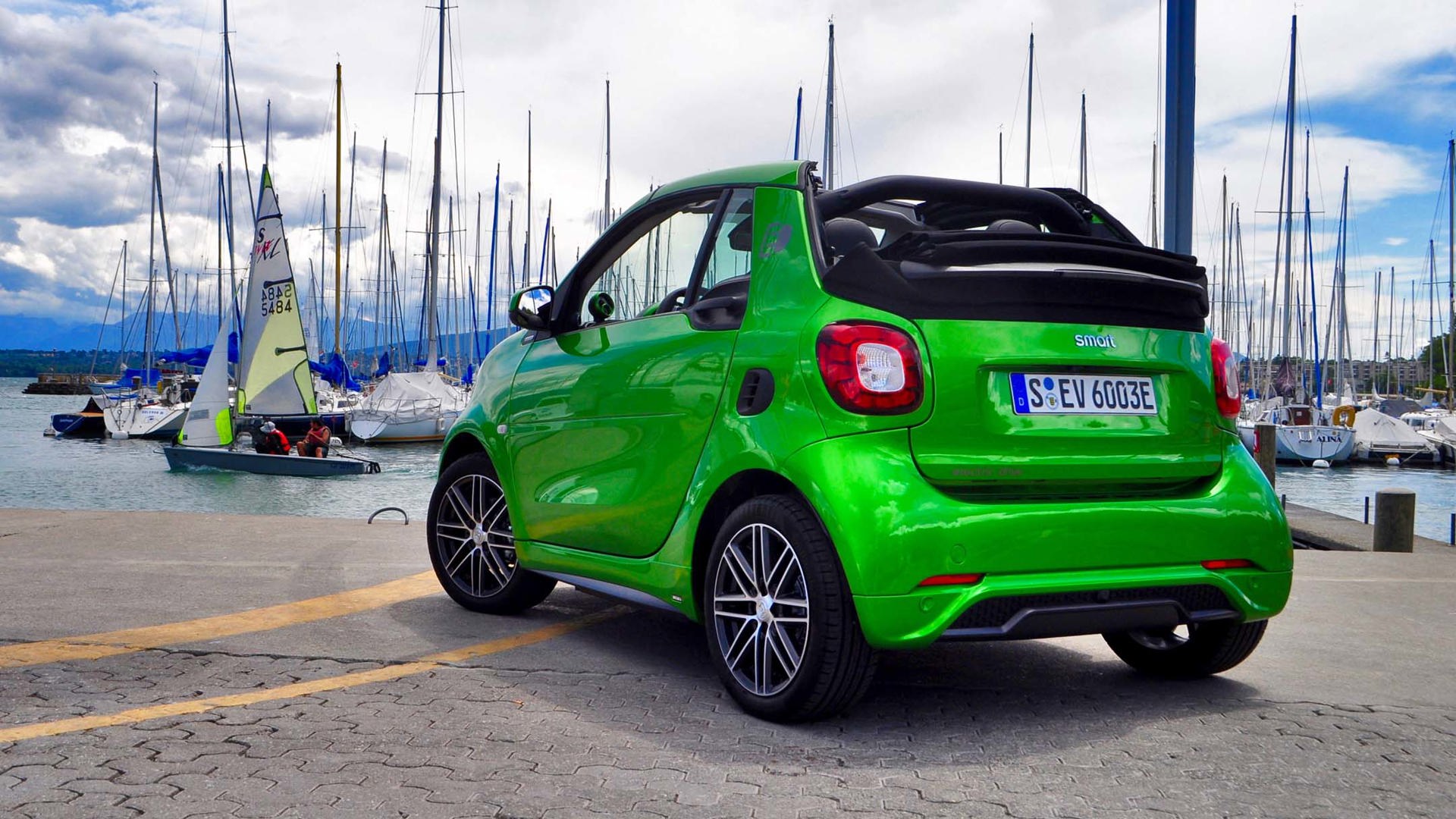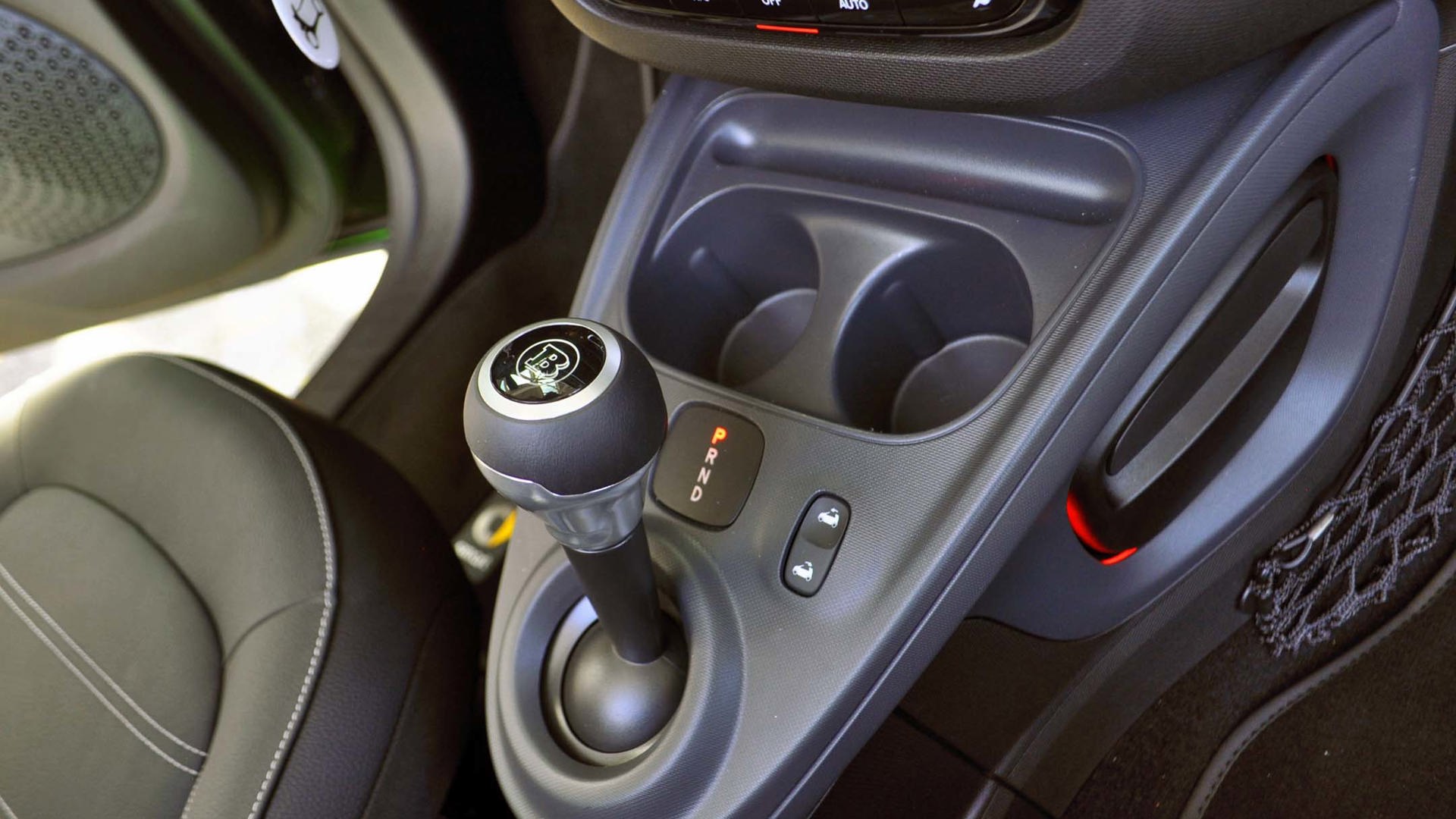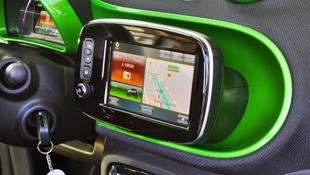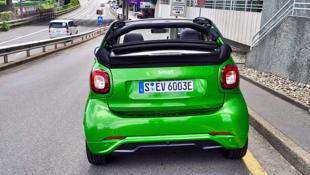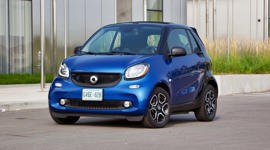GENEVA, Switzerland – Cheap and playful fun in the sun. That’s what the current and outgoing gas-powered 2017 Smart ForTwo Convertible offers. Yet once the all-electric version of the tiny two-seater replaces it later this year, Smart is going to go big on the fun and the cheap.
Fun and nimbleness with an urban chic
The fun – from the tidal wave of instantly generated torque down low, which made our 2017 Smart ForTwo Electric Drive Cabrio respond to each prod of the accelerator like it was flying out the office door towards a sunny long weekend.
It poked, thrust and glided quicker through the traffic-clogged streets of downtown Geneva than many of the pricier convertibles it passed that day – handy, when you especially need a sanity-preserving escape route from gridlock frustration.
The cheap – dives below the gas Smart thanks to government electric car rebates in the three biggest provincial markets for electric Smarts: Ontario, Quebec and British Columbia. For all-electric cars with big beefy batteries such as the Smart, there’s a $5,000 rebate in BC (plus another $3,250 ScrapIt rebate if you simultaneously recycle your old car), to $8,000 in la belle province, to a heaping $13,000 rebate off in Ontario. This, off a Smart Electric Drive convertible expected to start around $32,000.
That’s right, $13,000 (after tax) off your all-new $32k-ish droptop may yet happen this year, at least in Ontario.
Convertible coming by late summer, hopefully
Or there’s a possibility it may not happen this year at all. Originally, this Smart EV coupe – which is really a two-door hatchback but referred to as coupe by Smart, so let’s go with that – and electric convertible were to go on sale in April 2017. Now officials are listing late August/September for the arrival of a few examples of the 2017 ForTwo ED coupe and convertible, and October for the 2018 models, thanks to what Mercedes-Benz is officially calling certification delays on the ’17s.
The fall is clearly not ideal timing when you want to launch a car with a disappearing roof to the Canadian market, thus the trickle of “better late than never” ’17s. However, between the market timing, the current four- to six-month delay, the piling-up of orders for electric coupes and cabs already, and what one Daimler official called “unexpectedly high demand” for electric Smarts right up to the end of 2017, those who want their Smart ED by the end of the year may have to act sooner than later – especially for these convertible BEVs (battery electric vehicles) we drove.
If you haven’t paid much attention to electric cars yet, BEVs run on electricity only, and no gasoline whatsoever, so are more prone to the dreaded “range anxiety”, thanks to much longer charge times compared to filling up a gas tank. The in-between option is a plug-in hybrid electric vehicle (PHEV) that can also run on gasoline, but tend to have smaller batteries – all of these are typically lumped into the catchall terms “EV”, “electric”, or “plug-in”.
The fact that Canadian Smart ForTwo ED Cabrio buyers will likely miss out on a full summer’s worth of driving now is a shame, because there’s a lot to like in these small and funky BEVs.
Playful but useful, for a two-seater
Styling-wise, you can’t really take yourself too seriously if you’re driving a teeny tiny Smart convertible. It exudes fun and nimbleness with an urban chic, although some will find its easy park-ability and super tight turning circle (6.95 metres) too little reward for the inconvenience of having only two seats and relatively limited cargo space (190 litres with the passenger seat up, 350 with it down).
The Cosmic Green of the ForTwo ED Convertible we hustled through the streets of Geneva was a special-order paint that won’t be available in Canada, though a similarly bright Electric Green Tridion Cell frame with either all-white or all-black (including wheels) colour schemes are exclusive to ED versions of the Smart. Those ED graphics – cleverly designed to look like a plug and outlet – on the safety frame just above the door handles is the quickest visual indicator that you’re looking at an electric Smart.
The cheap and cheerful theme continues inside with body-colour accents from the vents, gauges and relatively small screen. One which uses a TomTom navigation system that proved just a little slow occasionally when circling roundabouts, but got us where we needed to go, eventually. The unique automatic temperature control has a sliding magnifying glass tab to mark the temperature you desire, a cute yet somewhat retro feature.
Heated seats and a heated steering wheel are standard on electric Smarts, The seats are leather, but the overarching theme is less luxury and more funky. Hard plastics abound, and closing the door with the windows closed elicits some un-Mercedes-like door clatter.
There’s a unique state-of-charge gauge awkwardly stuck onto the top of the dash to the left of the steering wheel, while the remaining range also appears in the digital display in front of the driver. Turning the air conditioning on instantly lowers the available range, in our case roughly 10 km (though it varies widely); based on personal winter experience with BEVs, it’s likely that warming up the car will take a larger bite out of range than A/C.
Range slightly improved, but still low, at roughly 115 km
Official NRCan range estimates haven’t been released yet, but the last one was rated at 109 km, and this one promises 10 percent better range, so between 110 and 120 is the most realistic real-world figure, said Smart brand execs at the launch. The European official range estimate is a very optimistic 155 km, with even those same company officials calling it “an artificial figure” before citing the 110–120 km range.
The 17.2 kilowatt-hour (kWh) battery is largely the same as before, so it still takes a lengthy 13 hours or so to charge up fully from a 20 percent charge using a typical 12 amp circuit. But once the owner installs a 240-volt Level 2 charger at home – a highly recommended accessory for all Canadian BEV drivers – this is cut down to a much more reasonable 2.5 hours, thanks to the upgraded onboard charger – from a 3.3 to a 7 kilowatt system – that vacuums up those electrons faster.
These Level 2 stations typically cost $500–$1,500, and a similar amount for installation in most garages or driveways, with rebates available from both Quebec and Ontario of up to $1,000 total to go towards these costs.
To help extend its range further, or just to impress your friends, there’s an app coming to Canada mid-year that will allow you to warm or cool the cabin from your phone, tablet or desktop. Ideally this’ll be done when plugged in, so you can hop into a comfortable car with a full battery, and not have to burn precious (but much cheaper than gas) onboard electrons to do it.
If you’re in full hyper-miler mode to stretch out your range, there’s an Eco button that gives the driver a few kilometres of extra breathing room. You’ll want to avoid this mode in general though, if you appreciate the ForTwo ED’s off-the-line thrust, as it dulls throttle response greatly, while increasing the regenerative braking effect that also slows the car down quicker when off the accelerator.
Energetic response and super silence define its driving feel
That energetic response comes courtesy a large 60 kW electric motor, which produces 118 lb-ft of torque literally right from the get-go. This means a serious push in the back when you first prod the throttle, though it tends to lose that oomph somewhat as you approach highway speeds, as suggested by the 11.5 second 0–100 km/h acceleration time.
Top speed is 130 km/h, and I can guarantee you will cut your range down significantly if you spend much time anywhere near this speed.
The electric ForTwo responds to steering inputs smoothly but quickly, though there’s not much in the way of a sporty steering feel here. Handling from the rear-wheel-drive convertible is sporty firm but not quite sporty flat when attacking highway onramps – it seems more in its element with a video-game-like quick steering feel in the city.
Comfort-wise, there’s plenty of legroom, but elbow room between driver and front passenger can become somewhat intimate, especially if you’re using the centre cupholders. And the passenger seat also has a fabric strap at its base that can be used to strap down briefcases or bags, or bend away unnoticeably when someone sits on it, as we did without discovering it until the end of our half-day in it.
ForTwo ED Cabrio likely cheapest drop-top in town
Exact MSRPs for the electric convertible are set to be finalized in July, but the upcoming ’17 Smart Electric Drive Coupe to be launched at the same time has been confirmed at $28,800. That’s roughly $1,800 over the previous electric coupe, so a similar amount on the convertible side would mean a starting price around $32,000.
Once the all-electric Smart ForTwo models eventually arrive in Canada, it will once again be the only new EV drop-top on the market – the least expensive drop-top overall in the country (neck and neck with the Fiat 500c), at least for buyers in British Columbia, Quebec and for slam-dunk certain in Ontario.
Wait a minute, didn’t autoTRADER.ca report late last year a rebate much closer to Ontario’s original $8,500 EV rebate would be coming to the Smart ForTwo Electric Drive Coupe? We did indeed, but the Ontario EV incentive program changed in February this year to remove a provision that limited the incentive to 30 percent of the zero-emission car’s MSRP.
That means less-expensive battery-electric vehicles such as the Smart ForTwo ED and Mitsubishi i-MiEV now have access to a much more eye-opening $13,000 incentive, which could have been $14K if either offered five seats.
Sure, those discounts are applied after HST is added on, plus you may have to wait to receive money back from the government if your dealer doesn’t agree to submit the paperwork on your behalf.
Mine came in the form of a cheque that arrived by mail five weeks after my new Leaf purchase – your timing may vary, but some dealers will agree to roll the incentive into lease and finance payments, then claim the rebate back from the government. So if you can’t or won’t wait for an indeterminate amount of time for your provincial rebate, this should be a key question when you’re EV shopping.
Great for folks with their own charging, but not otherwise
With no quick-charging from regular household outlets in North America, the Smart ED Cabrio is great for owners with access to a garage or EV charging at work, but not so great for the many downtown condo and apartment owners who don’t.
Its closest rival is likely the Mitsubishi i-MiEV, which has the advantage of similarly cheeky looks plus four doors and a back seat, but much less range, oomph and a much rougher interior than this Smart.
The brand itself is taking a big risk going all-electric from here on in, given that on this continent, Smart EV sales made up roughly 30 percent of sales when both gas and electric versions were offered. But given the growing charging infrastructure, and expanding incentives – which will likely be improved further by the end of 2017 by Ontario and possibly the Canadian government – this inexpensive convertible may save you a lot more than just cutting out your gas bills.
